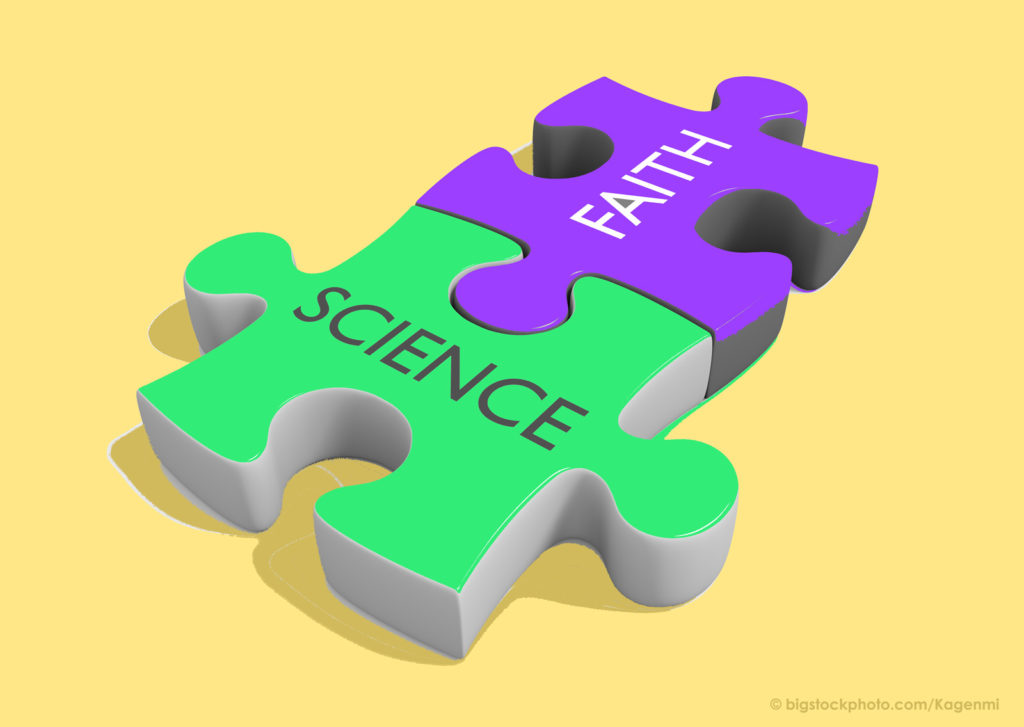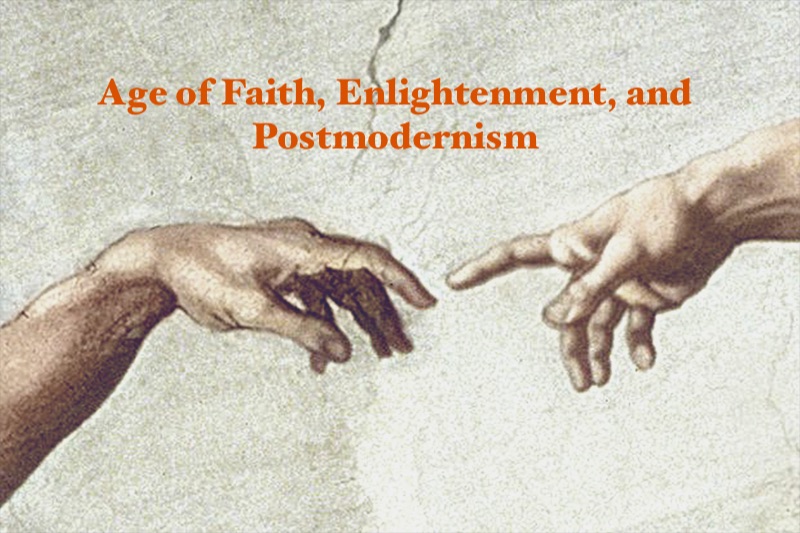
Image from Clayton, J.N. (2017). Science and Theology, May 19, By DGE?
For many of us, faith implies the belief in a Deity and powers that emanate from such a being. We conceive of such beliefs as beyond the reach of the intellect, and see science and faith, like oil and water, as not mixing very well. This creates a mindset in which we judge scientists as incapable or unwilling to express faith, and those who express faith as unable to understand the scientific viewpoint. Valid or not, many reasons have led to this unusual, unhelpful, and twisted logic. In an attempt to bring these two polar opposite views into synchrony, I describe a perspective on the path from skepticism to wonder and back that may provide a small beginning.
What is “truth?” How we arrive at that answer creates a multitude of feelings, thoughts, and approaches. Most of us, at the dawn of the 21st century, reflect the thinking which conceives of truth based on faith in opposition to that based on science. Science is a unique method requiring proof to an almost legalistic level, i.e., overwhelming circumstantial evidence that is beyond a reasonable doubt. We arrive at this type of truth by gathering data from what we experience. We then generate a best-guess explaining the accumulated evidence, test this hypothesis, and recalibrate the explanation based on the feedback. This is a painstaking, time-consuming, third-person, communal perspective. History has validated the worthiness of this approach, such as when evaluating pre-scientific explanations of diseases. For millennia, we considered disorders the work of unseen forces, evil spirits, or the devil. Applying the scientific method, scientists discovered that biological phenomena, including bacteria and viruses, and psychological events such as stress, were better explanations for these dynamics.
In contrast to science, faith is the willingness to accept things unexperienced. It rests on an individualized, first-person feeling based on trust and conviction, and less on evidence or proof. It is an extrasensory set of feelings and ideas in an individual, regardless of how others may react. I cannot, for example, convince others with data or reasoning that I experience God every day because, right or wrong, this is a private, individualized, and exclusive experience. It becomes more communal only when others experience similar things.
The paradox inherent in this science-faith discussion arises from theology and philosophy, namely the idea of the transcendence and immanence of God. This dichotomy reflects a pair of truths which appear to contradict each other. Imagine a continuum. At one end is the notion that God is separable from His creation. Or to put a theological spin on it, “God is transcendent and not imminent.” He created things, but those things do not define Him. He is beyond them. However, to believe in God’s transcendence and to neglect His immanence is to fall into the belief of a Supreme being and creator who does not intervene in the universe. At the other end of this continuum is the notion that nature expresses the Divine. God is nature. Or, to put it another way, “He is imminent (in nature).” But to believe in His immanence and to neglect His transcendence is to fall into the belief that reality is identical to divinity. Interestingly, modern Christian theology falls somewhere along this continuum. It argues that God is both transcendent and imminent, although imminent in only a few circumstances, such as the incarnation of Christ, the Bible, expressed love and caring. But He is not imminent in nature, pain, or inappropriate behavior.
Scholars have argued that the influence of Greek philosophy had a vast impact on early Christian theology and on the transcendence-imminence of God. It saw the world of physical objects as an inferior reality. Because of this influence, any human experience of God, which is physical and inferior to the spirit, would only be a poor mirage of the true perfection of the godhead (Crotty, 1982). The result of such thinking was an emphasis on the transcendent over the immanent God. Several scholars tried to reject these Greek ideas. Aristotle, and later Dietrich Bonhoeffer, believed that God is “out there” with ordinary life. Bonhoeffer’s “God is everywhere” concept, however, morphed into “God is not here” for everything with God meant nothing is God. Logical reasoning, such as this, unfortunately, never seems to get anywhere.
During the Middle Ages, particularly the 12th and 13th century, the precursor of the scientific method was Scholasticism. Its distinguishing characteristics were inclusion of the teachings of Christian faith in pursuing truth. The goal of this approach was more about uncovering the wonder in nature by refining the questions posed, rather than expecting a conclusive answer. The result was an understanding that forces existed beyond the intellect but which harnessed a unique understanding. Such insightful thinking morphed into one that focused more on the answers than on the wonderment surrounding the answers. This gave birth to scientism and the prevalent method of science used today. While we have learned much from this modern approach, we have lost that most valuable part of life—an appreciation of the mystery and wonder that surrounds our “answers.”
Reconnecting wonder to God’s creation paradoxically resolves the science-faith conundrum. Science becomes the study of creation, wonder and all, and faith reflects communion with this wonder. This is the uneasy answer most organized religion and organized science ought to seek. Not a return to classic Scholasticism, but a new scholasticism suited to modern sensibilities and intellectual needs. It is an uneasy answer because history shows that we have and will continue to find scientific explanations for what was once the domain of the Divine. Yet, scientists grow skeptical that the scientific method can provide answers to all problems. And those mysteries that remain, e.g., death, love, and guilt, appear to be the most fundamental ones. Hence, we cannot continue to ignore the wonder of creation, or we will not gain true insight.
I have argued in a previous blog that science and faith-based knowledge are two distinct strategies to know the world. Our brains synchronize these two approaches. Rather than using them as opposing strategies, they are complementary, facilitating and enriching each another. True faith results from questioning. Faith stripped of skepticism is brittle and breaks easily. We must confront and wrestle with paradoxes—not just believe them unquestionably. It is the wrestling that produces insight, grace, and enlightenment. Along with wonder, we need to regain the willingness to face these contradictions and the false certainty they create.

